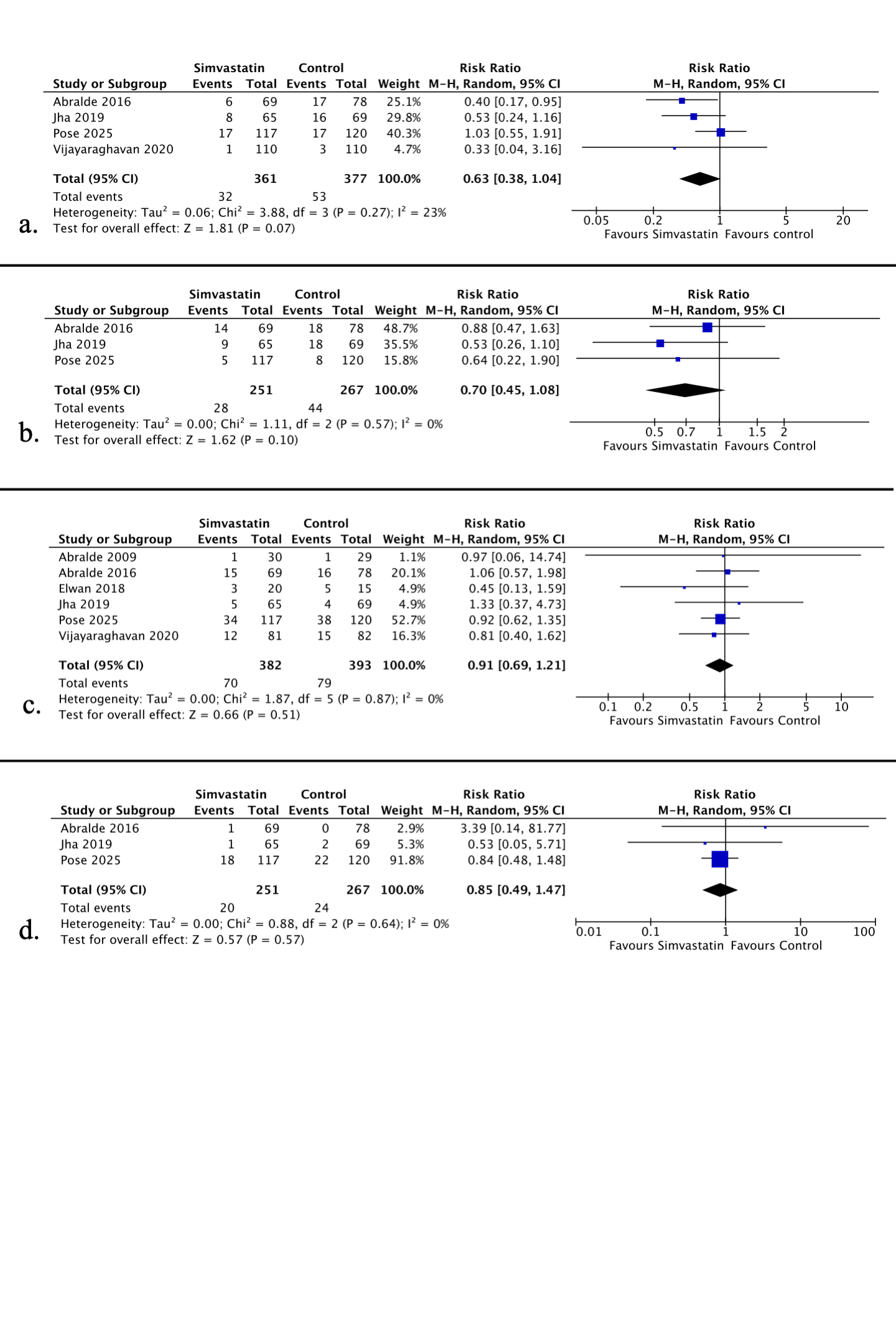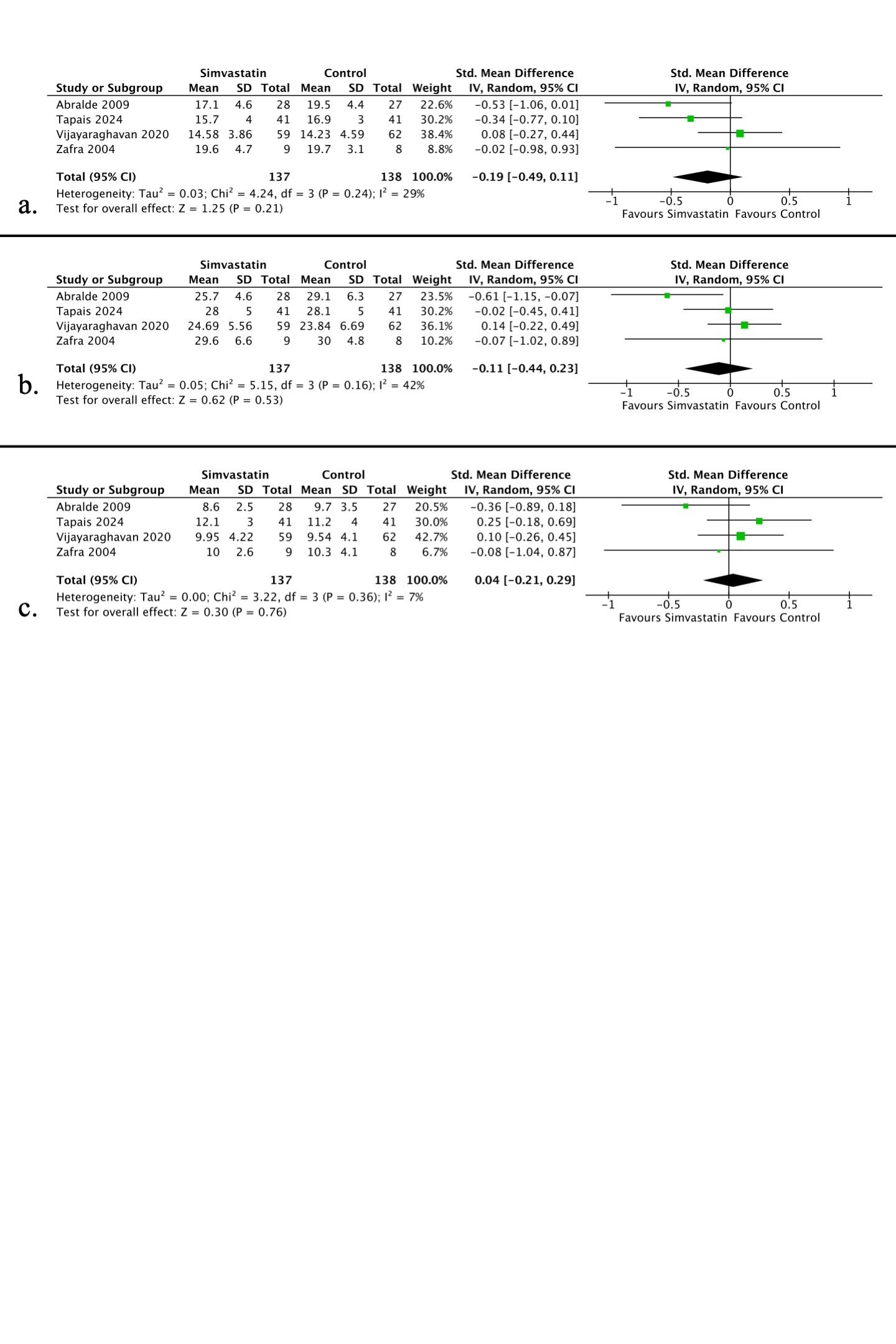Monday Poster Session
Category: Liver
P3696 - Role of Simvastatin as an Adjunct Therapy in Liver Cirrhosis: An Updated Meta-Analysis of Randomized Controlled Trials
Monday, October 27, 2025
10:30 AM - 4:00 PM PDT
Location: Exhibit Hall
- HT
Hareem Tahir, MD
University of South Dakota Sanford School of Medicine
Sioux Falls, SD
Presenting Author(s)
Muhammad Fahad Iqbal Khan, MBBS1, Muhammad Haris Khan, MBBS2, Zain Afridi, MBBS1, Muhammad Zahid Anwar, MBBS3, Ali Nawaz, MBBS4, Muhammad Usama Nawaz, MBBS5, Umama Malik, MBBS6, Muhammad Hamad Ali, MBBS4, Fatima Faraz, MBBS7, Fahad Ali, 8, Malik Sheheryar, MBBS4, Huda Habib, MBBS9, Muhammad Siddique Karimi, MBBS10, Hareem Tahir, MD11, Shahbaz Ahmad, MBBS12
1Khyber Medical College, Peshawar, North-West Frontier, Pakistan; 2District Headquarter Hospital, Dera Ismail Khan, Dera Ismail Khan, North-West Frontier, Pakistan; 3Lady Reading Hospital, Nowshera, North-West Frontier, Pakistan; 4Lady Reading Hospital, Peshawar, North-West Frontier, Pakistan; 5Saidu Medical College, Swat, North-West Frontier, Pakistan; 6PAK International Medical College, Peshawar, North-West Frontier, Pakistan; 7Rawalpindi Medical University, Rawalpindi, Punjab, Pakistan; 8Khyber College of Dentistry, Peshawar, North-West Frontier, Pakistan; 9Services Institute of Medical Sciences, Lahore, Punjab, Pakistan; 10Saidu Teaching Hospital, Swat, North-West Frontier, Pakistan; 11University of South Dakota Sanford School of Medicine, Sioux Falls, SD; 12Ayub Medical College, Abbotabad, North-West Frontier, Pakistan
Introduction: The clinical efficacy of simvastatin as an adjunct therapy in patients with liver cirrhosis remains uncertain. Statins are believed to reduce portal pressure and suppress inflammation. We conducted a meta-analysis to assess the clinical impact of simvastatin in patients with liver cirrhosis.
Methods: We performed a systematic literature search in PubMed, Embase, Cochrane Library, and ClinicalTrials.gov using MeSH terms for ‘Simvastatin’ and ‘Liver Cirrhosis’. All randomized controlled trials (RCTs) evaluating simvastatin as an adjunct therapy compared with controls were included. For continuous outcomes, standardized mean differences (SMDs) were pooled; for dichotomous outcomes, risk ratios (RRs) were calculated. All estimates were presented with 95% confidence intervals (CIs) and combined with a random-effects model.
Results: Total 9 studies recruiting 1,014 patients were included. Four studies reported on the effect of simvastatin on mortality, with no significant difference observed between the simvastatin and control groups [risk ratio (RR): 0.63; 95% confidence interval (CI), 0.38 -1.04; P = 0.07]. Both groups were comparable in terms of complications such as Bleeding [RR 0.70, 95% CI 0.45 - 1.08; P= 0.10], new or worsening ascites [RR 0.91, 95% CI 0.69 - 1.21; P= 0.51], and development of acute kidney injury or hepatorenal syndrome [RR 0.85, 95% CI 0.649 - 1.87; P= 0.57]. There was no statistically significant difference in hepatic hemodynamic measurements such as Hepatic Venous Pressure Gradient (HVPG) [standardized mean difference (SMD) -0.19, 95% CI -0.49 - 0.11; P= 0.21], Wedged Hepatic Venous Pressure (WHVP) [ SMD -0.11, 95% CI -0.44 - 0.23; P= 0.53], and Free Hepatic Venous Pressure (FHVP) [SMD 0.04, 95% CI -0.21 - 0.29; P= 0.76] between the two groups.
Discussion: This meta-analysis demonstrates that simvastatin as an adjunct therapy in patients with liver cirrhosis, does not significantly impact mortality, incidence of complications (including bleeding, ascites, and renal dysfunction) or hepatic hemodynamic parameters. Although statins have shown theoretical benefits in reducing portal pressure and inflammation, the current evidence does not support a clear clinical advantage of simvastatin in this population. Further high-quality, large scale and adequately powered randomized controlled trials are warranted to better clarify its potential role in the management of liver cirrhosis.

Figure: Figure 1: Forest plots comparing outcomes between the simvastatin and control groups: (a) Mortality; (b) Bleeding; (c) New or worsening ascites; (d) Acute kidney injury.

Figure: Figure 2: Forest plots comparing hepatic hemodynamic measurements between the simvastatin and control groups: (a) HVPG; (b) WHVP; (c) FWHVP.
Disclosures:
Muhammad Fahad Iqbal Khan indicated no relevant financial relationships.
Muhammad Haris Khan indicated no relevant financial relationships.
Zain Afridi indicated no relevant financial relationships.
Muhammad Zahid Anwar indicated no relevant financial relationships.
Ali Nawaz indicated no relevant financial relationships.
Muhammad Usama Nawaz indicated no relevant financial relationships.
Umama Malik indicated no relevant financial relationships.
Muhammad Hamad Ali indicated no relevant financial relationships.
Fatima Faraz indicated no relevant financial relationships.
Fahad Ali indicated no relevant financial relationships.
Malik Sheheryar indicated no relevant financial relationships.
Huda Habib indicated no relevant financial relationships.
Muhammad Siddique Karimi indicated no relevant financial relationships.
Hareem Tahir indicated no relevant financial relationships.
Shahbaz Ahmad indicated no relevant financial relationships.
Muhammad Fahad Iqbal Khan, MBBS1, Muhammad Haris Khan, MBBS2, Zain Afridi, MBBS1, Muhammad Zahid Anwar, MBBS3, Ali Nawaz, MBBS4, Muhammad Usama Nawaz, MBBS5, Umama Malik, MBBS6, Muhammad Hamad Ali, MBBS4, Fatima Faraz, MBBS7, Fahad Ali, 8, Malik Sheheryar, MBBS4, Huda Habib, MBBS9, Muhammad Siddique Karimi, MBBS10, Hareem Tahir, MD11, Shahbaz Ahmad, MBBS12. P3696 - Role of Simvastatin as an Adjunct Therapy in Liver Cirrhosis: An Updated Meta-Analysis of Randomized Controlled Trials, ACG 2025 Annual Scientific Meeting Abstracts. Phoenix, AZ: American College of Gastroenterology.
1Khyber Medical College, Peshawar, North-West Frontier, Pakistan; 2District Headquarter Hospital, Dera Ismail Khan, Dera Ismail Khan, North-West Frontier, Pakistan; 3Lady Reading Hospital, Nowshera, North-West Frontier, Pakistan; 4Lady Reading Hospital, Peshawar, North-West Frontier, Pakistan; 5Saidu Medical College, Swat, North-West Frontier, Pakistan; 6PAK International Medical College, Peshawar, North-West Frontier, Pakistan; 7Rawalpindi Medical University, Rawalpindi, Punjab, Pakistan; 8Khyber College of Dentistry, Peshawar, North-West Frontier, Pakistan; 9Services Institute of Medical Sciences, Lahore, Punjab, Pakistan; 10Saidu Teaching Hospital, Swat, North-West Frontier, Pakistan; 11University of South Dakota Sanford School of Medicine, Sioux Falls, SD; 12Ayub Medical College, Abbotabad, North-West Frontier, Pakistan
Introduction: The clinical efficacy of simvastatin as an adjunct therapy in patients with liver cirrhosis remains uncertain. Statins are believed to reduce portal pressure and suppress inflammation. We conducted a meta-analysis to assess the clinical impact of simvastatin in patients with liver cirrhosis.
Methods: We performed a systematic literature search in PubMed, Embase, Cochrane Library, and ClinicalTrials.gov using MeSH terms for ‘Simvastatin’ and ‘Liver Cirrhosis’. All randomized controlled trials (RCTs) evaluating simvastatin as an adjunct therapy compared with controls were included. For continuous outcomes, standardized mean differences (SMDs) were pooled; for dichotomous outcomes, risk ratios (RRs) were calculated. All estimates were presented with 95% confidence intervals (CIs) and combined with a random-effects model.
Results: Total 9 studies recruiting 1,014 patients were included. Four studies reported on the effect of simvastatin on mortality, with no significant difference observed between the simvastatin and control groups [risk ratio (RR): 0.63; 95% confidence interval (CI), 0.38 -1.04; P = 0.07]. Both groups were comparable in terms of complications such as Bleeding [RR 0.70, 95% CI 0.45 - 1.08; P= 0.10], new or worsening ascites [RR 0.91, 95% CI 0.69 - 1.21; P= 0.51], and development of acute kidney injury or hepatorenal syndrome [RR 0.85, 95% CI 0.649 - 1.87; P= 0.57]. There was no statistically significant difference in hepatic hemodynamic measurements such as Hepatic Venous Pressure Gradient (HVPG) [standardized mean difference (SMD) -0.19, 95% CI -0.49 - 0.11; P= 0.21], Wedged Hepatic Venous Pressure (WHVP) [ SMD -0.11, 95% CI -0.44 - 0.23; P= 0.53], and Free Hepatic Venous Pressure (FHVP) [SMD 0.04, 95% CI -0.21 - 0.29; P= 0.76] between the two groups.
Discussion: This meta-analysis demonstrates that simvastatin as an adjunct therapy in patients with liver cirrhosis, does not significantly impact mortality, incidence of complications (including bleeding, ascites, and renal dysfunction) or hepatic hemodynamic parameters. Although statins have shown theoretical benefits in reducing portal pressure and inflammation, the current evidence does not support a clear clinical advantage of simvastatin in this population. Further high-quality, large scale and adequately powered randomized controlled trials are warranted to better clarify its potential role in the management of liver cirrhosis.

Figure: Figure 1: Forest plots comparing outcomes between the simvastatin and control groups: (a) Mortality; (b) Bleeding; (c) New or worsening ascites; (d) Acute kidney injury.

Figure: Figure 2: Forest plots comparing hepatic hemodynamic measurements between the simvastatin and control groups: (a) HVPG; (b) WHVP; (c) FWHVP.
Disclosures:
Muhammad Fahad Iqbal Khan indicated no relevant financial relationships.
Muhammad Haris Khan indicated no relevant financial relationships.
Zain Afridi indicated no relevant financial relationships.
Muhammad Zahid Anwar indicated no relevant financial relationships.
Ali Nawaz indicated no relevant financial relationships.
Muhammad Usama Nawaz indicated no relevant financial relationships.
Umama Malik indicated no relevant financial relationships.
Muhammad Hamad Ali indicated no relevant financial relationships.
Fatima Faraz indicated no relevant financial relationships.
Fahad Ali indicated no relevant financial relationships.
Malik Sheheryar indicated no relevant financial relationships.
Huda Habib indicated no relevant financial relationships.
Muhammad Siddique Karimi indicated no relevant financial relationships.
Hareem Tahir indicated no relevant financial relationships.
Shahbaz Ahmad indicated no relevant financial relationships.
Muhammad Fahad Iqbal Khan, MBBS1, Muhammad Haris Khan, MBBS2, Zain Afridi, MBBS1, Muhammad Zahid Anwar, MBBS3, Ali Nawaz, MBBS4, Muhammad Usama Nawaz, MBBS5, Umama Malik, MBBS6, Muhammad Hamad Ali, MBBS4, Fatima Faraz, MBBS7, Fahad Ali, 8, Malik Sheheryar, MBBS4, Huda Habib, MBBS9, Muhammad Siddique Karimi, MBBS10, Hareem Tahir, MD11, Shahbaz Ahmad, MBBS12. P3696 - Role of Simvastatin as an Adjunct Therapy in Liver Cirrhosis: An Updated Meta-Analysis of Randomized Controlled Trials, ACG 2025 Annual Scientific Meeting Abstracts. Phoenix, AZ: American College of Gastroenterology.
